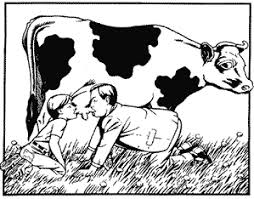
 David R. Tener, DC
David R. Tener, DC
The Goldberg Tener Clinic
Chronic Disease Reversal since 1976
Is drinking the milk of a cow really natural?
The phrase “finish your milk” is a directive just as common in most American households as “finish your vegetables.” Most of us can remember the famous “Got Milk” and “Milk Mustache” ads of the 1980’s and 90’s which further reinforced the need to drink milk daily if we wanted to grow up healthy and strong like our favorite athletes, movie stars and rock stars. Since that time, however, the purported health benefits of dairy consumption have gradually been called into question and concerns about milk’s role in the rising rates of obesity, diabetes, allergies, digestive disorders and other chronic health problems have been raised. Have we been sold a bill of goods?
Cow’s milk is for a calf, not a human.
Mother cows, much like human mothers, produce milk to nourish their young after birth. Both calves and human infants will naturally nurse for a finite period of time until the natural dietary can be taken. Calves nurse for a period of 8-11 months and will consume approximately 20% of their body weight per day of milk during that time. Human infants in general nurse for a period of 1-2 years or longer depending on the culture and will consume approximately 19-30 ounces of milk per day. The nutritional composition of milk for both calves and humans is finely tuned to meet the nutritional needs of each animal. The nutritional composition of cow’s milk differs considerably from human milk as seen in the figure below. Cow’s milk is the perfect food for nursing calves. Human breast milk is the perfect food for nursing human infants.
Once weaned, the human infant much like the baby calf will transition onto its natural dietary and the mother will no longer produce milk for her young. It is not biologically appropriate to consume milk after the nursing period, and no species on earth will naturally do so. Not even a cow drinks milk!
Somewhere along the lines of human history, mankind extended the nursing period to include the rest of adult life. This is perhaps one of the most bizarre and illogical behaviors humans have engaged in. We make the additional mistake (and a rather bizarre one at the that) of consuming the milk not even of our own species (which would be somewhat more appropriate) but rather that of another animal for which we were not biologically designed. We have no more need for the milk of a cow than we do for the milk of a dog, giraffe or monkey.
Milk…Does it really do our body good?
The dairy industry will have us believe that cow’s milk is a requirement of human nutrition and of good health. Clever marketing tactics and advertising campaigns produced by the milk industry encourage us to take dairy products regularly to reduce the risk of osteoporosis, maintain lean muscle mass and improve cardiovascular health. The “Got Milk Mustache Ads” featuring celebrities of all kinds is one of the most recognizable ad campaigns of all time, but it is nothing more than propaganda produced by an industry that stands to make millions of dollars from our ongoing consumption of their products.
Dairy products are a health hazard. Milk is one of the most common offenders for those with digestive, allergic, hormonal and autoimmune conditions. The proteins in cows milk (casein, whey, lacto-albumins) are particularly offensive which is why dairy is one of the most common food allergens seen in medical practice. Further complicating matters is our inability to digest milk sugar, lactose, beyond the age of one at which time we no longer produce the enzyme lactase.





